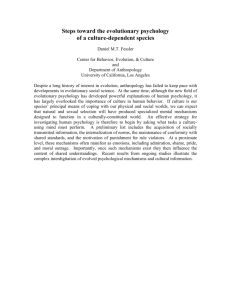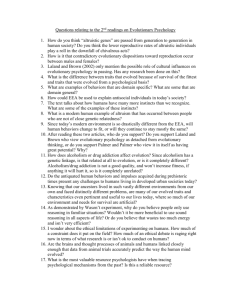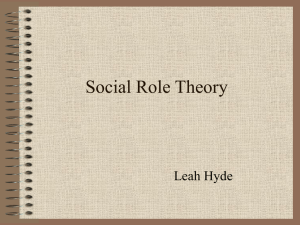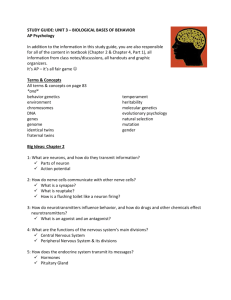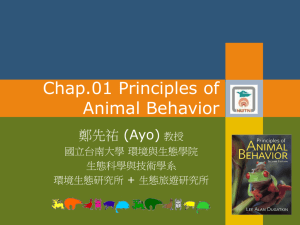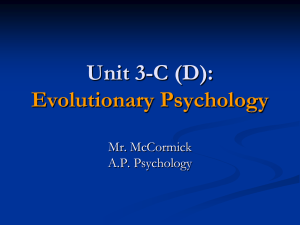Papers:
advertisement
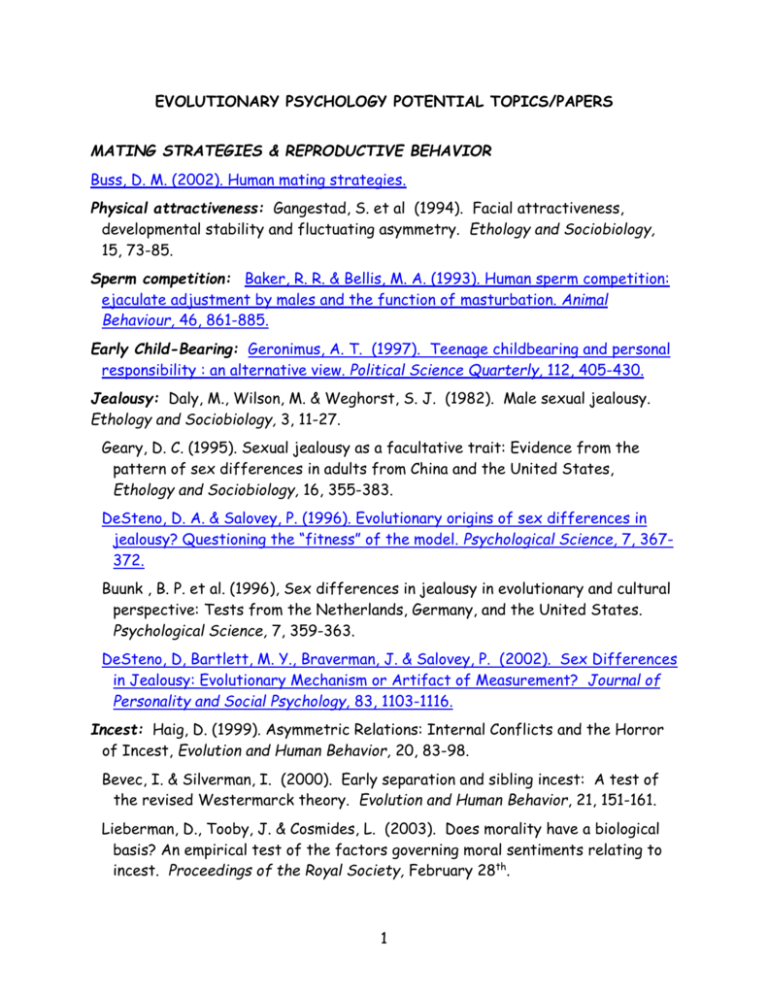
EVOLUTIONARY PSYCHOLOGY POTENTIAL TOPICS/PAPERS MATING STRATEGIES & REPRODUCTIVE BEHAVIOR Buss, D. M. (2002). Human mating strategies. Physical attractiveness: Gangestad, S. et al (1994). Facial attractiveness, developmental stability and fluctuating asymmetry. Ethology and Sociobiology, 15, 73-85. Sperm competition: Baker, R. R. & Bellis, M. A. (1993). Human sperm competition: ejaculate adjustment by males and the function of masturbation. Animal Behaviour, 46, 861-885. Early Child-Bearing: Geronimus, A. T. (1997). Teenage childbearing and personal responsibility : an alternative view. Political Science Quarterly, 112, 405-430. Jealousy: Daly, M., Wilson, M. & Weghorst, S. J. (1982). Male sexual jealousy. Ethology and Sociobiology, 3, 11-27. Geary, D. C. (1995). Sexual jealousy as a facultative trait: Evidence from the pattern of sex differences in adults from China and the United States, Ethology and Sociobiology, 16, 355-383. DeSteno, D. A. & Salovey, P. (1996). Evolutionary origins of sex differences in jealousy? Questioning the “fitness” of the model. Psychological Science, 7, 367372. Buunk , B. P. et al. (1996), Sex differences in jealousy in evolutionary and cultural perspective: Tests from the Netherlands, Germany, and the United States. Psychological Science, 7, 359-363. DeSteno, D, Bartlett, M. Y., Braverman, J. & Salovey, P. (2002). Sex Differences in Jealousy: Evolutionary Mechanism or Artifact of Measurement? Journal of Personality and Social Psychology, 83, 1103-1116. Incest: Haig, D. (1999). Asymmetric Relations: Internal Conflicts and the Horror of Incest, Evolution and Human Behavior, 20, 83-98. Bevec, I. & Silverman, I. (2000). Early separation and sibling incest: A test of the revised Westermarck theory. Evolution and Human Behavior, 21, 151-161. Lieberman, D., Tooby, J. & Cosmides, L. (2003). Does morality have a biological basis? An empirical test of the factors governing moral sentiments relating to incest. Proceedings of the Royal Society, February 28th. 1 Concealed ovulation: Benshoof, L. & Thornhill, R. (1979). Evolution of monogamy and concealed ovulation in humans. Journal of Social Biology and Structure, 2, 95-106. Strassman, B. I. (1981). Sexual selection, parental care and concealed ovulation in humans. Ethology and Sociobiology, 2, 31-40. Homosexuality: R. C. Kirkpatrick et al. (2000). The Evolution of human homosexual behavior. Current Anthropology, 41, 385-413. Bailey, J. M. et al (2000). Genetic and Environmental Influences on Sexual Orientation and Its Correlates in an Australian Twin Sample. Journal of Personality and Social Psychology, 78, 524-536. Zietsch, B. P. et al (2008). Genetic factors predisposing to homosexuality may increase mating success in heterosexuals. Evolution and Human Behavior, 29, 424-433. Santtila, P. et al (2009). Testing Miller’s theory of alleles preventing androgenization as an evolutionary explanation for the genetic predisposition for male homosexuality. Evolution and Human Behavior, 30, 58-65. Bogaert, A. F. (2006). Biological versus nonbiological older brothers and men’s sexual orientation. Proceedings of the National Academy of Sciences, 103, 10771-10774. Vasey, P. L. & VanderLaan, D.P. (2009). Avuncular tendencies in Samoan fa’afafine and the evolution of male androphilia. Archives of Sexual Behavior, in press. Iemmola, F. & Ciani, A. C. (2009). New evidence of genetic factors influencing sexual orientation in men: female fecundity increase in the maternal line. Archives of Sexual Behavior, in press. Paternal confidence: Gaulin, S. J. C. & Schlegel, A. (1980). Paternity confidence and paternal investment: a cross-cultural test of a sociobiological hypothesis. Ethology and Sociobiology, 1, 301-309. PARENTING & RELATED TOPICS Pair-bonding: Quinlan, R. J. & Quinlan, M. B. (2008). Human lactation, pair-bonds, and alloparents: A cross-cultural analysis. Human Nature, 19, 87-102. Child Abuse: Daly, M. & Wilson, M. (1985). Child abuse and other risks of not living with both parents. Ethology & Sociobiology, 6, 197-210. 2 Menopause: Hill & Hurtado (1991). The evolution of premature reproductive senescence and menopause in human females. Human Nature, 2, 313-350. Peccei, J. S. (1995). The origin and evolution of menopause: The altricialitylifespan hypothesis, Evolution and Human Behavior, 16, 425-449. Hawkes et al (1998). Grandmothering, menopause and the evolution of human life histories. Proceedings of the National Academy of Sciences, 95, 1336-1339. Attachment: Chisholm, J. S. (1998). The evolutionary ecology of attachment organization. Human Nature, 7, 1-38. ALTRUSIM, KIN SELECTION, RECIPROCITY Boehm, C. (1997). The natural selection of altruistic traits. Human Nature, 10, 205252. Mulder, M. B. (2007). Hamilton’s rule and kin selection: the Kipsigis case. Evolution and Human Behavior, 28, 299-312. Gintis, H. et al. (2003). Explaining altruistic behavior in humans. Evolution and Human Behavior, 24, 153-172. Quinlan, R. J. & Flinn, M. V. (2005). Kinship, sex, and fitness in a Caribbean community. Human Nature, 16, 32-57. WARFARE, AGGRESSION, RISK-TAKING Bigelow, R. (1972). The evolution of cooperation, aggression and self-control. Nebraska Symposium on Motivation, 20, 1-57. Campbell, D. T. (1975). On the conflicts between biological and social evolution and between psychology and moral tradition. American Psychologist, 30, 1103–1126. Durham, W. C. (1976). Resource competition and human aggression: Part I: A review of primitive war. Quarterly Review of Biology, 51, 385-415. Chagnon, N. (1983). Yanomamo: The Fierce People. New York: Holt, Rinehart and Winston. Wilson, M. & Daly, M. (1985). Competitiveness, risk taking, and violence: the young male syndrome, Ethology and Sociobiology, 6, 59-73. Daly, M. & Wilson, M. (1989). Homicide and cultural evolution. Ethology and Sociobiology, 10, 99-110. 3 Otterbein, K. F. (1997). The origins of war. Critical Review, 11, 251-277. Flinn, M. V., Geary, D. C. & Ward, C. V. (2005). Ecological dominance, social competition, and coalitionary arms races: Why humans evolved extraordinary intelligence. Evolution and Human Behavior, 26, 10-46. . COGNITIVE PSYCHOLOGY Unconscious motivation: Buller, D. J. (1999). DeFreuding Evolutionary Psychology: Adaptation and Human Motivation. In Where Biology Meets Psychology: Philosophical Essays (pp. 99-114), Ed. V. G. Hardcastle. Cambridge, MA: MIT Press/Bradford Books. Self deception: Lockard, J. L. & Paulhus, D. L. (1988). Self-deception: An adaptive mechanism? Prentice Hall: NJ. Trivers, R. (2000). The elements of a scientific theory of self-deception. New York Academy of Sciences, 114-131. Cognitive modules: Gigerenzer, G., & Hug, K. (1992). Domain-specific reasoning: Social contracts, cheating and perspective change. Cognition, 43, 127-171. Sperber, D. & Girotto, V. (2002). Use or misuse of the selection task? Rejoinder to Fiddick, Cosmides, and Tooby, Cognition, 85, 277-290. Mealey, L. et al (1996). Enhanced memory for the faces of cheaters. Ethology and Sociobiology, 17, 119-128. Cummins, D. D. (1999). Cheater detection is modified by social rank: The impact of dominance on the evolution of cognitive functions, Evolution and Human Behavior, 20, 229-248. Spatial abilities: Voyer, D., Voyer, S., & Bryden, M. P. (1995). Magnitude of sex differences in spatial abilities: A meta-analysis and consideration of critical variables. Psychological Bulletin, 117, 250–270. Ecuyer-Dab, I & Robert, M. (2007). The female advantage in object location memory according to the foraging hypothesis: A critical analysis. Human Nature, 18, 365-385. Language: Pinker, S. & Bloom, P. (1992). Natural language and natural selection. In Barkow, J. H., Cosmides, L. & Tooby, J. (Eds.), The Adapted Mind: Evolutionary Psychology and the Generation of Culture, Oxford University Press, pp 451-494. 4 Fernald, A. (1992). Human maternal vocalizations to infants as biologically relevant signals: An evolutionary perspective. In Barkow, J. H., Cosmides, L. & Tooby, J. (Eds.), The Adapted Mind: Evolutionary Psychology and the Generation of Culture, Oxford University Press, pp 391-428. Emotional expression: Brown, W. M., Palameta, B. and Moore, C. (2003). Are there nonverbal cues to commitment? An exploratory study using the zero-acquaintance video presentation paradigm. Evolutionary Psychology, 1, 42-69. PSYCHOPATHOLOGY & ABNORMAL PSYCHOLOGY ADHD: Chuansheng, C., Burton, M., Greenberger, E., & Dmitrieva, J. (1999). Population migration and the variation of dopamine D4 receptor (DRD4) allele frequencies around the globe, Evolution and Human Behavior, 20, 309-324 Autism: Shaner, A., Miller, G., & Mintz, J. (2004). Autism as the Low-Fitness Extreme of a Parentally Selected Fitness Indicator. Human Nature, 19, 389-413. Frith et al (1991). The cognitive basis of a biological disorder. Trends in Neurosciences, 14, 433-438. Baron-Cohen, S. (2002). The extreme male brain theory of autism. Trends in Cognitive Sciences, 6, 248-254. Bushwick, N. L. (2001). Social learning and the etiology of autism. New Ideas in Psychology, 19, 49-75. Anxiety: Marks, I. M. & Nesse, R. M. (1994). Fear and fitness: An evolutionary analysis. Ethology and Sociobiology, 15, 247-261. Eating disorders: Faer, L. M., Hendricks, A., Abed, R., & Figueredo, A. J. (2005). The evolutionary psychology of eating disorders: Female competition for mates or for status? Psychology and Psychotherapy: Theory, Research and Practice, 78, 397–417. Salmon, C., Crawford, C., Dane, L. & Zuberbier, O. (2008). Ancestral mechanisms in modern environments: Impact of competition and stressors on body image and dieting behavior. Human Nature, 19, 103-117. Fears and phobias: Öhman, A. & Mineka, S. (2001). Fears, phobias and preparedness: Toward an evolved module of fear and fear learning. Psychological Review, 108, 483-522. Gerdes, A. B. M. et al. (2009). Spiders are special: fear and disgust evoked by pictures of arthropods. Evolution and Human Behavior, 30, 66-73. 5 Post-partum depression: Hagen, E. H. (2002). Depression as bargaining: The case postpartum. Evolution and Human Behavior, 23, 323-336. Rape: Thornhill, R. & Thornhill, N. W. (1983). Human rape: An evolutionary analysis. Ethology and Sociobiology, 4, 137-173. Jones, O. D. (1999). Sex, culture and the biology of rape: Toward explanation and prevention. California Law Review, 87, 827-942. Palmer, C. T., and Thornhill, R. (2003). A posse of good citizens brings outlaw evolutionists to justice. A response to Evolution, Gender, and Rape. Edited by Cheryl Brown Travis. (2003). Cambridge, MA: MIT Press. Evolutionary Psychology, 1, 10-27. Schizophrenia: Shaner, A., Miller, G., & Mintz, J. (2004). Schizophrenia as one extreme of a sexually selected fitness indicator. Schizophrenia Research, 70, 101–109. D. R. Wilson critique of this paper. Sociopathy: Mealey, L. (1995). The sociobiology of sociopathy. Behavioral and Brain Sciences, 18, 523-599. Lalumière,M.T., Harris, M. G. & Rice,M. E. (2001). Psychopathy and developmental instability. Evolution and Human Behavior, 22, 75–92. Suicide: de Catazano, D. (1995). Reproductive Status, Family Interactions, and Suicidal Ideation: Surveys of the General Public and High-Risk Groups. Evolution and Human Behavior, 16, 385-394. INDIVIDUAL DIFFERENCES & PERSONALITY Nettle, D. (2007). An evolutionary approach to the extraversion continuum. Evolution and Human Behavior, 26, 363-373. Buss & Greiling (1999). Adaptive individual differences. Journal of Personality. Figueredo, A.J., Vásquez, G., Brumbach, B.H., & Schneider, S.M.R. (2007). The Kfactor, covitality, and personality: A psychometric test of life history theory. Human Nature, 18, 47–73. CULTURAL EVOLUTION Henrich, J., Boyd, R. & Richerson, P. J. (2008). Five misunderstandings about cultural evolution. Human Nature, 19, 119-137. 6 Flinn, M. V. (1997). Culture and the evolution of social learning. Evolution and Human Behavior, 18, 23-67. VARIOUS ODD TOPICS Race & discrimination: Kurzban, R., Tooby, J., & Cosmides, L. (2001) Can race be erased? Coalitional computation and social categorization. Proc. Natl. Acad. Sci. USA, 98, 15387-15392. Food selection and preparation: Sherman, P. W. & Hash, G. A. (2001). Why vegetable recipes are not very spicy. Evolution and Human Behavior, 22, 147-163. Morning sickness: Flaxman, S. M. & Sherman, P. W. (2002). Is morning sickness maladaptive? Trends in Ecology & Evolution, 17, 359. Lactose intolerance: Bloom, G. & Sherman, P. W. (2004). Dairying barriers affect the distribution of lactose malaborption. Evolution and Human Behavior, 26, 301el. 7
